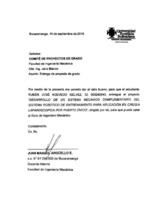Desarrollo de un sistema mecánico complementario del sistema robótico de entrenamiento para aplicación en cirugía laparoscópica por puerto único

View/
Date
2018Author
Acevedo Gelvez, Rubén José
xmlui.dri2xhtml.METS-1.0.item-advisor
Director. Argüello Espinosa, Juan Manuel
xmlui.dri2xhtml.METS-1.0.item-type
Trabajo de grado
Citación
Metadata
Show full item recordDocuments PDF
Abstract
Actualmente, para intervenir quirúrgicamente la zona pélvica-abdominal se utiliza la cirugía laparoscópica, donde a través de pequeñas incisiones se ingresan los instrumentos quirúrgicos necesarios, con el beneficio de reducir los efectos y tiempos postoperatorios. Para mejorar aún más el uso de esta técnica, se incursiona la cirugía laparoscópica por puerto único que reduce todas las incisiones de la técnica original a una sola, evolucionando así para obtener mejores resultados. No obstante, hoy en día es reducida la cantidad de médicos capacitados para realizar dicho procedimiento. En consecuencia, en la facultad de Ingeniería Electrónica de la Universidad Pontificia Bolivariana se plantea el desarrollo de un sistema robótico de entrenamiento para la aplicación de cirugía laparoscópica por puerto único como un proyecto de maestría, que consiste en el uso de dos interfaces hápticas que funcionan como una herramienta maestra y una interfaz porta herramienta, respectivamente. Este proyecto abarca varios campos de ingeniería y uno de ellos es el diseño mecánico, donde no se tiene el conocimiento por parte de los encargados de dicho proyecto. Se ve la necesidad de plantear un proyecto de apoyo a cargo de un estudiante de Ingeniería Mecánica; encargándose este del desarrollo del sistema mecánico. Este proyecto paralelo debe cumplir con las necesidades que plantea el proyecto de maestría, como los grados de libertad del instrumento quirúrgico, la capacidad de acoplarse a la interfaz porta herramienta, etcétera. Al final de este proyecto, se obtiene como resultado un prototipo funcional que puede ser utilizado en el sistema de entrenamiento del proyecto de maestría. Aunque este posee un sobredimensionamiento por el método de fabricación por impresión 3D que no permite la producción de piezas más pequeñas, se demuestra que este proceso puede ser utilizado en la fabricación de estos dispositivos, pues permite la generación de geometrías complejas y eficaces. Nowadays, to intervene on the pelvic-abdominal area, is used the laparoscopic surgery, where the necessary surgical instruments are inserted through small incisions, to get the benefit of reducing the effects and postoperative times. To improve the use of this technique, it's explored in laparoscopic surgery by single port, which reduces all the incisions of the original technique to only one, thus evolving to obtain better results. However, today the number of trained doctors to perform this procedure is reduced. Consequently, in the Faculty of Electronic Engineering of the Universidad Pontificia Bolivariana, is proposed the development of a robotic training system for the application of laparoscopic surgery by single port as a master project, consisting of the use of two haptic interfaces that work as a master tool and a tool-holder interface, respectively. This project covers several fields of engineering and one of them is mechanical design, where who are in charge, don't have enough knowledge. So, they have the need to propose a support project by a student of Mechanical Engineering; taking charge of the development and design of the mechanical system. This parallel project must supply the needs of the master project, such as the degrees of freedom of the surgical instrument, the ability to couple to the tool interface, etc. At the end of this project, we obtain as a result a functional prototype which can be used in the robotic training system of the master project. Although this has an oversized due to the method of 3D printing manufacturing that doesn't allow the production of smaller pieces, it is shown that this process can be used in the manufacture of these devices, because it allows the generation of complex and efficient geometries.
Collections
- Trabajos de grado [6698]
The following license files are associated with this item:

